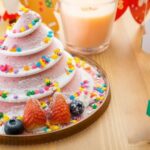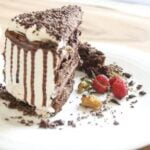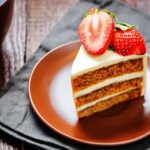Decorating with cake frosting is an art form that can transform a simple cake into a stunning masterpiece. The way frosting is applied can make or break the overall aesthetic of a cake.
In this blog, we will explore the various methods and techniques on how to decorate with cake frosting, from basic spreading to intricate designs. Whether you’re a beginner looking to improve your skills or an experienced baker seeking inspiration, this guide will provide you with the knowledge needed to create beautiful and delicious cakes.
Cake frosting comes in different forms, each offering unique textures and flavors. From buttercream to royal icing, fondant to ganache, the type of frosting you choose can greatly impact the final look of your cake. Understanding the characteristics of each type of frosting will help you achieve your desired decorating outcome.
Along with discussing the types of frostings, we will also delve into essential tools needed for decorating such as piping bags, tips, spatulas, and offset spatulas. Having the right tools at your disposal is crucial for executing professional-looking decorations.
Before diving into decorating techniques, it’s important to properly prepare your cake for frosting. This includes leveling the layers, filling them with delicious fillings, and applying a crumb coat to ensure smooth and even frosting application later on.
We will also cover basic frosting techniques like spreading, piping, and smoothing for beginners before getting into more advanced techniques such as fondant covering and intricate piping designs. Stay tuned as we explore color options, flavor variations, troubleshooting tips, and creative ideas for using cake frosting to elevate your baked creations.
Types of Cake Frosting
When it comes to decorating a cake, the type of frosting you use can make a huge difference in both the appearance and taste of your creation. There are several different types of frostings to choose from, each with its own unique characteristics and uses. Knowing the differences between buttercream, royal icing, fondant, and ganache can help you choose the right one for your cake decorating project.
Here are the different types of cake frosting to consider:
- Buttercream: An all-time favorite for many bakers, buttercream is creamy, smooth, and easy to work with. It can be flavored and colored in various ways, making it versatile for different cake designs.
- Royal Icing: This type of frosting dries to a hard finish, making it ideal for intricate piping designs on cookies or cakes. It’s commonly used for decorating gingerbread houses as well.
- Fondant: Fondant is a rolled icing that provides a smooth finish on cakes. It allows for intricate designs and shapes to be molded onto the cake, giving a professional look.
- Ganache: Made from chocolate and cream, ganache is rich and glossy. It can be used as a glaze or whipped into a thicker consistency for filling layers or frosting cakes.
Each type of frosting has its strengths and weaknesses when it comes to decorating with cake frosting – so consider the style of cake you want to create when choosing which one will work best for your project. Understanding these distinctions will help you achieve the desired look and taste for your creation.
While all these frostings may vary in their application techniques, they all share one common goal – to enhance the visual appeal of your cakes. Experimenting with different types of frostings opens up a world of creativity in cake decorating. With practice and patience, you’ll become more comfortable using various frosting types to bring your cake visions to life in delicious ways.
Tools Needed
Decorating a cake with frosting can be a fun and creative process, but having the right tools is essential to achieve professional-looking results. Whether you are a beginner or an experienced baker, having the proper tools can make all the difference in your decorating skills.
One of the most important tools for cake frosting is the piping bag, which allows you to create intricate designs and patterns on your cake. Piping bags come in different sizes and materials, so it’s essential to choose one that fits your needs.
In addition to piping bags, investing in a variety of piping tips is crucial for achieving different textures and designs with your frosting. From star tips to round tips, each tip creates a unique pattern when frosting a cake. Spatulas are another indispensable tool for cake decorating, used for spreading frosting smoothly on the sides and top of the cake. Offset spatulas are especially useful for achieving clean edges and smooth finishes on your frosted cakes.
When it comes to decorating cakes with frosting, having the right tools can elevate your creations from ordinary to extraordinary. Along with piping bags, tips, spatulas, and offset spatulas, other tools like turntables and bench scrapers can also aid in creating flawless designs on your cakes.
Investing in quality tools will not only improve the final look of your cakes but also make the decorating process more enjoyable and efficient. So next time you embark on a cake decorating project, make sure you have all the essential tools needed to bring your creative vision to life with beautiful cake frosting designs.
Experimenting with different tools and techniques when decorating with cake frosting can open up a world of possibilities for creating unique and eye-catching designs that will impress your friends and family. Whether you prefer simple decorations or intricate patterns, having the right tools at your disposal can help you achieve any desired look on your cakes.
So don’t be afraid to explore new techniques and get creative with how you use piping bags, tips, spatulas, and offset spatulas in your cake decorating endeavors. With practice and patience, you’ll soon discover how to decorate with cake frosting like a pro.
Preparing the Cake
When it comes to decorating a cake with frosting, the preparation of the cake itself plays a crucial role in ensuring a beautiful and professional-looking final result. Before you can begin to unleash your creativity with different frosting techniques, it is essential to properly prepare the cake for the task at hand. In this section, we will explore some valuable tips on how to prepare your cake for frosting, including leveling, filling layers, and applying a crumb coat.
Leveling the Cake
One of the first steps in preparing a cake for frosting is making sure that it has an even surface. Uneven cakes can make it challenging to achieve smooth and uniform frosting coverage. To level your cake layers, you can use a long serrated knife or a cake leveler tool. Carefully slice off any domed tops or uneven areas to create a flat surface that will serve as the foundation for your frosting.
Filling Layers
Once your cake layers are leveled, you may want to add fillings between them to enhance flavor and texture. Whether you choose to use fruit preserves, flavored buttercream, pudding, or ganache as fillings, make sure to spread them evenly across each layer. Use a piping bag or offset spatula to create an even layer of filling that extends all the way to the edges of the cake.
Crumb Coating
Before applying your final layer of frosting, it is highly recommended to apply a crumb coat first. A crumb coat is a thin layer of frosting that seals in any loose crumbs from the cake’s surface, preventing them from showing up in your final decorations.
Spread a thin layer of frosting over the entire cake using an offset spatula, then chill the cake in the refrigerator for about 15 minutes before proceeding with your main coating of frosting. This extra step will help you achieve cleaner and smoother results when decorating with cake frosting.
Basic Frosting Techniques
Spreading
When it comes to basic frosting techniques, spreading is one of the most essential skills for beginners. To achieve a smooth and even coat of frosting on your cake, start by placing a generous amount of frosting on top of the cake. Then, using an offset spatula, gently spread the frosting from the center outwards in a circular motion. Make sure to cover the entire surface evenly and adjust the thickness based on your preference.
Piping
Piping is another fundamental technique that can add decorative elements to your cakes. To start piping, fill a piping bag fitted with a decorating tip with your desired frosting color. Hold the piping bag at a 90-degree angle to the cake and apply pressure to create different designs such as borders, swirls, or written messages. Practice with different tips and pressures to create various effects and enhance your cake decorations.
Smoothing
Achieving a smooth finish on your cake can elevate its overall appearance and appeal. After spreading or piping your frosting, use a bench scraper or icing smoother to gently go around the sides of the cake to remove any excess frosting and create clean edges.
For the top surface, you can use an offset spatula or icing smoother to level out any bumps or imperfections. Take your time and be patient with this process to achieve professional-looking results when decorating with cake frosting.
By mastering these basic frosting techniques like spreading, piping, and smoothing, beginners can enhance their cake decorating skills and create beautiful designs with ease. Remember that practice makes perfect when it comes to working with cake frostings, so don’t be afraid to experiment and try new techniques to unleash your creativity in decorating confectionery delights.
Advanced Frosting Techniques
When it comes to decorating cakes with frosting, mastering advanced techniques can take your creations to the next level. One popular method is fondant covering, where a smooth layer of fondant is rolled out and draped over the cake for a flawless finish. Fondant allows for intricate designs and shapes to be easily created, making it a favorite among professional bakers and cake decorators. To achieve a seamless look when using fondant, follow these steps:
- Start by preparing your cake with a thin layer of buttercream frosting to help the fondant adhere.
- Roll out the fondant on a clean surface dusted with powdered sugar to prevent sticking.
- Gently lift the rolled-out fondant using a rolling pin and carefully drape it over the cake, smoothing out any wrinkles or air bubbles as you go.
- Trim off any excess fondant around the base of the cake for a neat finish.
Intricate piping designs are another advanced frosting technique that can add elegance and sophistication to your cakes. Piping involves using a piping bag fitted with different tips to create decorative patterns, borders, and even lifelike flowers. Here are some tips for successful piping:
- Fill your piping bag with frosting and make sure to twist or tie off the end securely.
- Practice on a separate surface before piping directly onto your cake to get comfortable with different tip techniques.
- Apply consistent pressure when piping to achieve uniform lines or decorations.
- Clean your tips frequently between colors or designs to avoid color bleeding or mixing.
For those looking to add a trendy touch to their cakes, ombre frosting is a fun and visually appealing technique. Ombre frosting involves blending different shades of the same color on the cake for a gradient effect. This can be achieved by starting with one color at the bottom of the cake and gradually transitioning into lighter shades towards the top. Use an offset spatula or bench scraper to blend and smooth out each layer of frosting seamlessly.
By mastering these advanced frosting techniques like fondant covering, intricate piping designs, and ombre frosting, you can elevate your cakes from ordinary to extraordinary. Experiment with different styles, colors, and textures to unleash your creativity and impress everyone with your beautifully decorated creations.
Color and Flavors
When it comes to decorating with cake frosting, one of the most important aspects to consider is color and flavor. Not only does the color of the frosting play a crucial role in the overall aesthetic appeal of the cake, but the flavor can also enhance the taste and theme of your creation. Understanding how to effectively color frosting with food coloring and incorporate different flavor extracts can take your decorating skills to the next level.
Food coloring is essential for achieving vibrant and eye-catching hues in your frosting. Gel food coloring is preferred over liquid food coloring as it provides more intense colors without altering the consistency of the frosting. To achieve custom colors, mix different shades of gel food coloring until you reach your desired hue. It’s important to add food coloring in small increments to avoid overpowering the frosting and ending up with a color that is too dark or artificial.
In addition to coloring frosting, experimenting with different flavor extracts can elevate the taste profile of your decorated cakes. Whether you prefer classic vanilla, zesty lemon, rich chocolate, or floral almond, adding just a few drops of extract can infuse your frosting with delicious flavors.
Be sure to taste test as you go along to adjust the intensity of the flavor according to your preference. By mastering how to color frosting and incorporate various flavors, you can truly unleash your creativity and bring your cake decorating visions to life.
Troubleshooting
When it comes to decorating with cake frosting, there are some common issues that may arise during the process. One common problem is air bubbles in the frosting. To prevent this, make sure to properly mix the frosting and then gently tap the bowl on the counter to release any trapped air before using it. Additionally, when filling a piping bag with frosting, carefully push out any air pockets that may have formed.
Another challenge that decorators often face is melting frosting. This can happen if the temperature of your kitchen is too warm or if you are handling the frosting for an extended period. To prevent this, you can place your frosted cake in the refrigerator for a few minutes to help set the frosting. You can also try using a firmer type of frosting like ganache or buttercream with added stabilizers.
Uneven piping can also be a frustrating issue when decorating with frosting. To achieve smooth and consistent piping, practice good pressure control on the piping bag and maintain a steady hand while decorating. If you notice uneven piping lines, you can use an offset spatula to gently smooth out any imperfections or start over by scraping off the frosting and trying again.
| Common Issue | Troubleshooting Tip |
|---|---|
| Air Bubbles | Tap the bowl before using and remove air pockets from piping bag |
| Melting Frosting | Refrigerate frosted cake briefly or use firmer frosting types |
| Uneven Piping | Practice good pressure control and use an offset spatula for smoothing |
Inspiration and Ideas
Cake frosting is not just a finishing touch to a cake; it is an art form that can elevate the appearance and taste of any baked creation. From buttercream to fondant, the type of frosting used can greatly influence the final outcome of the design.
By understanding the different types of frosting available and mastering various decorating techniques, you can create stunning cakes that are sure to impress any audience. In this article, we have covered everything from basic frosting techniques for beginners to more advanced methods for seasoned bakers.
When it comes to decorating with cake frosting, having the right tools is essential. Piping bags, tips, spatulas, and offset spatulas are just some of the basic equipment needed to create beautiful designs on your cakes. Whether you are looking to achieve smooth finishes or intricate piping details, having the proper tools on hand will make the decorating process much smoother.
One of the most exciting aspects of decorating with cake frosting is experimenting with colors and flavors. By using food coloring and flavored extracts, you can customize your frosting to match any theme or taste preference. The possibilities are truly endless when it comes to creating vibrant designs that not only look amazing but also taste delicious. So go ahead and let your creativity run wild as you explore different ways on how to decorate with cake frosting.
Frequently Asked Questions
Can You Decorate With Store Bought Frosting?
Store-bought frosting can definitely be used for decorating, especially if you’re looking for convenience and ease of use. However, it’s important to note that the consistency may not always be ideal for intricate designs, so making adjustments like adding powdered sugar or food coloring may be necessary.
What Frosting Is Best for Cake Decorating?
When it comes to cake decorating, buttercream frosting is often considered the best option due to its versatility and ability to hold different shapes and textures. It can be easily piped into elaborate designs, smooth finishes, or even textured effects depending on the technique used. Additionally, buttercream frosting is delicious and easy to work with.
How to Decorate With Buttercream Frosting?
Decorating with buttercream frosting involves a few key steps to ensure success. First, make sure your cake is completely cooled before applying the frosting to avoid any melting or sliding. Then, choose the right piping tip for the desired design – a star tip for borders or rosettes, a round tip for writing, etc.
Next, practice your piping technique on parchment paper before moving onto the cake itself. Finally, have fun experimenting with different colors and textures to create a beautifully decorated cake that tastes just as good as it looks!

Welcome to my blog about home and family. This blog is a place where I will share my thoughts, ideas, and experiences related to these important topics. I am a stay-at-home mom with two young children. I hope you enjoy reading it! and may find some helpful tips and ideas that will make your home and family life even better!





